Not technically part of the CrookedRiver project, but this web site is a convenient place to update friends who have been following this other project – restoring a 1980 Cape Dory Typhoon in Nevis, West Indies where Trish and I live for much of the winter.
It all started with a dilapidated hull that had been laying on the hard for 20 years.
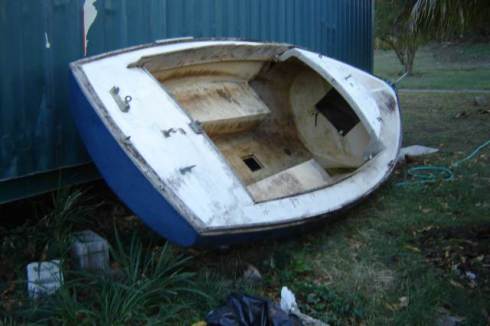
Before
She had recently been restored but was damaged in a storm around 1990, and her rudder broken off. She was put on the hard with the intention of fixing the rudder, which sadly never happened. So she sat and deteriorated – her hardware pilfered or “tiefed” as we say here, and over time her coaming boards were broken, and the rest of the teak deteriorated. The gelcoat was cracked and split, and her foam flotation soaked.
She had been one of the first pleasure yachts on Nevis. She was owned by the Cliffdwellers Hotel, one of the early hotels on Nevis, and was used for the enjoyment of the guests. She was just about perfect for the West Indies, with fairly high winds and seas. It is said that when the other sailboats are coming in, a Typhoon is going out. Her name was Combolo.
But it wasn’t a worst case scenario – the owner, a good friend, did have the mast and boom which were in good shape!
So always looking for a project, and always seduced by “potential” (see the rest of this web site), I decided to restore her. My friend Marcia, the owner, and I agreed we would be co-owners of the boat.
Did I mention I had never sailed in my life?
There is one man on island who does boat work, so we had a backhoe lift her onto a flatbed to take to his yard to get holes drilled in the gelcoat to dry out the foam core and then repair the gelcoat, replace the teak, paint her, and make a new rudder.
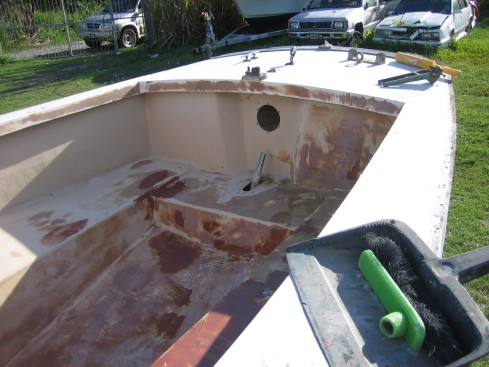
Boatyard Repairs
Meanwhile, I went on the hunt for parts, and how to make a new rudder. The internet makes this kind of thing SOOO much easier than years ago. There is a truly wonderful resource on the ‘net of Cape Dory’s – http://www.capedory.org, where they had posted the original manual for the boat, history of the lineage, etc, but most importantly had a users forum, with many dedicated, helpful and knowledgeable Typhoon owners. Cape Dory made thousands of boats, but only about a hundred of these, yet it seemed every owner of a Typhoon daysailer was on the list and extremely helpful, as were the owners of other Cape Dory’s.
The very first thing that happened when I posted my quest was an owner offered me some old sails for free! One of the greatest acts of generosity by a stranger I have experienced. He shipped them to SailCare for me who cleaned and refurbished them at very low cost. Next a fellow who goes by the name Oswego John, sent me a template for making a new rudder, complete with instructions on how to make one better than the original! Incredible support. I didn’t even know the names of half the parts I was looking for, but folks on the Cape Dory list helped me at every turn. Countless stupid questions, countless patient replies. One very fine feller even picked up some parts for me in Florida while on a trip there – just unbelievable. I can’t thank all those guys enough. Did I mention that I had never sailed in my life?
My intention was to restore her to as close to how she was built 30 years ago, so it took time and searching to find all the correct parts, many of which hadn’t been made in at least 20 years. The total time for restoration took about a year and a half.
Meanwhile, I read “The Annapolis Book of Seamanship” cover to cover twice, Trish and I took a 3-day Annapolis Sailing School course, and almost incidentally ended up buying a couple of trimarans in a distress sale. So I learned to sail enough to be competent.
So the restoration did get completed, and Terrence, the boat man, built a trailer for her, too.
And we launched her today. Although it did not go quite as planned.
Earlier in the week, we had stepped the mast by hand, using four guys, “Iwo Jima style” just to check all the new rigging to make sure it would work. That succeeded, but due to the unique setup of the Typhoon and our constant 20 knot winds, it took much more effort than needed.
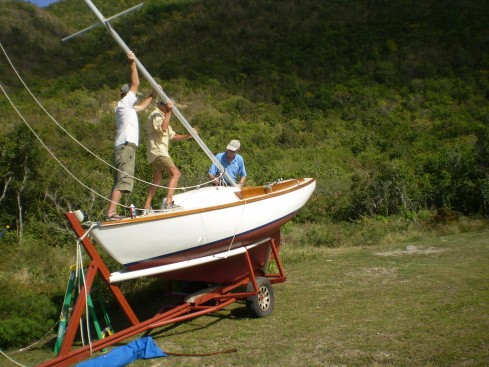
Mast stepping by hand
Coincidentally, (or not?) that feller, Paul, handling the butt end of the mast is just a visitor to Nevis, but was the first fellow to step the mast on this boat in 1980 (using the roof of a building), and took her on her maiden cruise. Unfortunately, he left island just a few days before launch which was postponed due to very high winds. He wanted to be there.
At a suggestion by a Cape Dory list member, I took a mast from one of the trimarans to use as a crane or “gin pole” and set it up to lift the mast up and out, and then to lift her again in place once we were at launch. That worked beautifully. So we hauled her down to Oualie Beach.
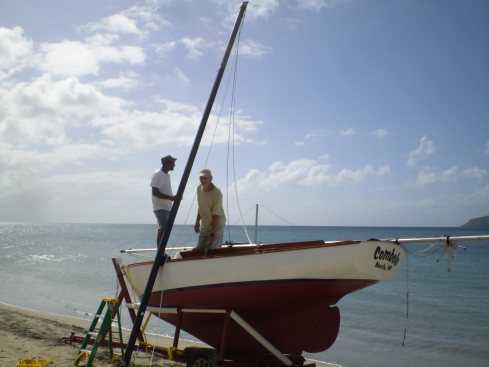
Gin Pole for Stepping the Mast
Once we got the mast stepped, we rigged her up, all ready to sail. Assisting in this was my good trimaran sailing buddy, Harry, who has been sailing for decades, Vishal, a friend who can do just about anything, and my friend Peter, who was teaching sailing to Annapolis cadets in the year I was born, founded and ran Outward Bound, accomplished racer, etc. So no small crew. My friend and co-owner Marcia arrived to rededicate Combolo’s launch after 20 years on the hard. She poured some of her favorite rum (Mount Gay) on her bow and performed all the proper ceremony.

Dedication
Then another good buddy, Christian, with a powerboat came out to haul her into the water from the beach. That’s when things didn’t go according to plan.
The trailer had been built such that it was almost neutral weight – you could pick up the tongue with the boat on it. We knew that – the boat and trailer had shifted positions when working on it – here it is in the “undesirable position”.

Tongue up
We had a line connecting the trailer to Christian’s boat to pull it out (backwards), and another connected to the trailer tongue to pull the trailer back in. The intention was to pull the boat and trailer out to the sea until she floated, and then pull them apart. But the mistake was that we relied on the weight of the boat on the trailer and disconnected all of the attaching lines between boat and trailer.
As Christian pulled the boat down into the sea, the trailer tipped backwards as shown above, but since the the boat was no longer attached to the trailer, she just fell into the sea in shallow water. Her rudder jammed and turned, and in the process snapped the tiller. You can see in the pic below the tiller I had spent hours and hours sanding, broken and worthless behind my unknowing (at the time) co-owner.
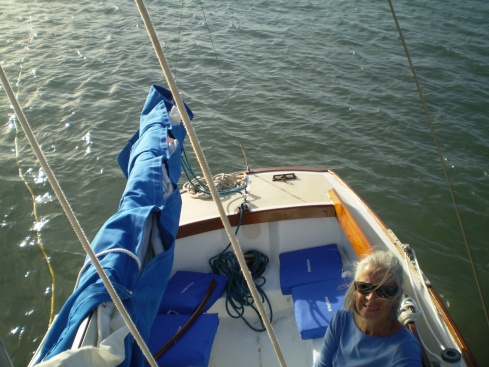
Broken Tiller
She was dug in the sand. Broken tiller. Half in and half out. But the rudder seemed ok.

DOH!
After several minutes of consternation and assessment of the situation, we decided that the better part of valor was to pull the trailer out from under the boat to give her more clearance, which we did.
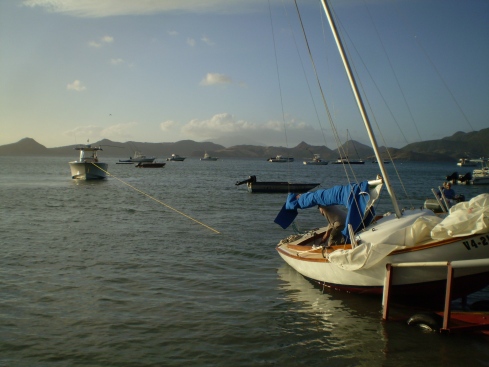
Try Again
Next step was to get her out of the sand. Just then, another acquaintance, Steve, who just so happens to be a boat builder, was on the beach and ordered that the main halyard be released, and he and a couple of other fellers used the standard technique of pulling the boat sideways to get her to float off of her “beached” state while Christian pulled her out.

Floating her
It worked!
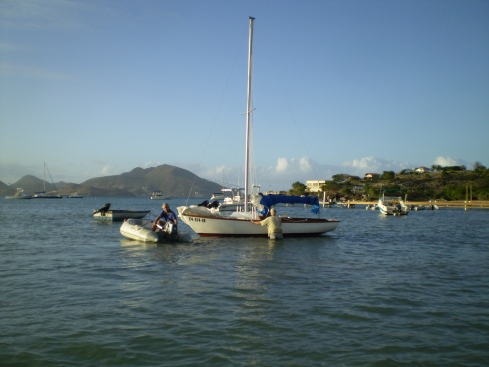
She floats!
Seems like the only damage to her is the broken tiller. As it happens, I’m leaving for the states tomorrow for two weeks and will get a replacement. Instead of sailing her, we towed her out to her mooring, attached her, and when I return with a new tiller, we should be set for sailing her for the first time in 20 years.
Not the result we anticipated for the day, but in the West Indies, you get used to set backs and saying “I can live with that”. We got her on the mooring for now. I can live with that.
I just can’t thank enough all the friends I have and have made along the way who have helped in this endeavor. Thank you, thank, you, thank you.
Update 13 March 2009
We realized that the launch had occurred on Friday the 13th (of Feb). That explained it. But she did get on her mooring.
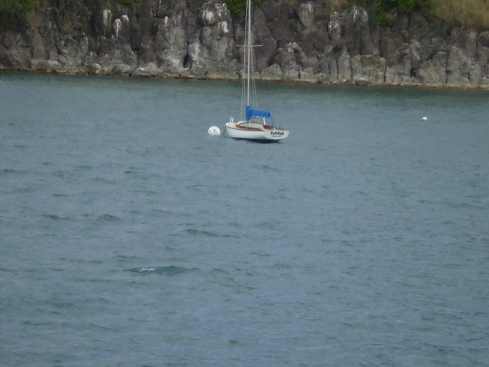
Combolo on Mooring
When I returned to island a couple of weeks later, my buddy Harry and I went out to Combolo and fixed a few things, including replacing the broken tiller, and took her out with just the mainsail, as it turned out that the jib that I got was actually a 120 percent genoa – way too big for our Caribbean trade winds.
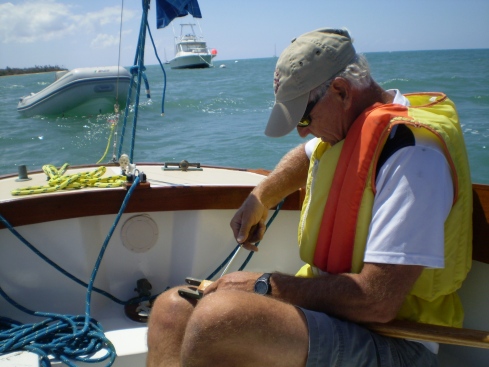
Harry working on the tiller
My co-owner, Marcia, has had more than her share of scares on Combolo (most recently the Friday the 13th of Feb launch), so she wanted to take her re-maiden voyage with our mutual friend Peter Willauer if not at the helm, at least on board. He’s the guy who was teaching sailing in the year that I was born. Did I mention that I had never been sailing before I agreed to restore this boat? Marcia is a very smart woman.
But Peter is leaving to take his J-42, Eight Bells, north in a couple of days, and today, again Friday the 13th, was the only day we could work it out for him to be aboard. Conditions were not ideal – “enhanced winds”, of about 20 knots, a northern swell of about 3M seas, and heavy cloud cover. And Peter insisted on us raising the genoa just to see what it was like.
It was fine, it really was. No, really ;-). A couple of small squalls came up that got us wet, and we were pretty over-powered with the genoa, but we had reefed the main so were ok. Peter and I had fun, and Marcia is also a sailer from way back, so she hung with the best of them, even with the long dingy ride in the rain back to the dock.
I left the camera at home and asked Trish to take a picture if she happened to see us pass by the house.

Sailing

4 comments
Comments feed for this article
February 14, 2009 at 4:03 pm
Dan Thomson
Outstanding job restoring an old gal like that. Ours is 3 years in the works – hope it comes out as nicely. Congratulations!
March 14, 2009 at 12:52 pm
John
A beautiful story, and a beautiful boat – well done!
John
CD28 Tantalus
(5 years into a 3 year restoration)
March 14, 2009 at 1:07 pm
Ron C
what a great story, I can imagine the work that went into this….but your final picture is so elegant, so beautiful, it justification for all that went before…in this world of disposable poorly made trash your revival of this fine boat is a magnificent gesture in the right direction
Cheers!
February 7, 2013 at 6:48 pm
Robbie Roberts
Good on ya!…….You saw a good boat through all that mess you began with. Great job. She is truely a fine boat. Happy Sailing!………………”Rob”